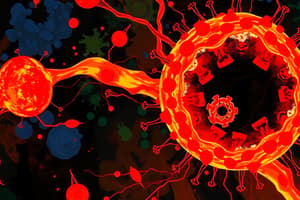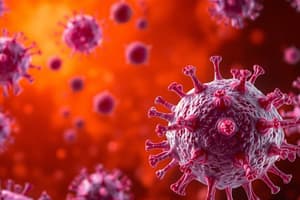Podcast
Questions and Answers
What is the primary purpose of inflammation in response to an irritant?
What is the primary purpose of inflammation in response to an irritant?
- To initiate tissue necrosis
- To localize and remove the irritant (correct)
- To facilitate rapid healing
- To promote systemic responses
Which type of inflammation is characterized by a gradual onset and prolonged duration?
Which type of inflammation is characterized by a gradual onset and prolonged duration?
- Allergic inflammation
- Chronic inflammation (correct)
- Acute inflammation
- Localized inflammation
Which cells primarily dominate in acute inflammation?
Which cells primarily dominate in acute inflammation?
- Plasma cells
- Polymorphonuclear leukocytes (PMNLs) (correct)
- Eosinophils
- Lymphocytes
What characterizes the difference between acute and chronic inflammation regarding exudate?
What characterizes the difference between acute and chronic inflammation regarding exudate?
What occurs to macrophages during the late stages of acute inflammation?
What occurs to macrophages during the late stages of acute inflammation?
What is the primary role of the fluid inflammatory exudate during tissue repair?
What is the primary role of the fluid inflammatory exudate during tissue repair?
Which microorganism is most commonly associated with the formation of abscesses?
Which microorganism is most commonly associated with the formation of abscesses?
What differentiates suppurative inflammation from non-suppurative inflammation?
What differentiates suppurative inflammation from non-suppurative inflammation?
During the development of an abscess, what is the consequence of PMNLs dying?
During the development of an abscess, what is the consequence of PMNLs dying?
What is a major characteristic of cellulitis?
What is a major characteristic of cellulitis?
Flashcards
Inflammation definition
Inflammation definition
Inflammation is the body's response to an irritant, involving local vascular, lymphatic, and cellular reactions to an injurious agent.
Acute inflammation
Acute inflammation
A rapid inflammatory response to a short-duration irritant, with noticeable tissue swelling and a high proportion of white blood cells involved.
Chronic inflammation
Chronic inflammation
A slow, prolonged inflammatory response to a persistent irritant, characterized by less swelling and more tissue repair/scarring.
Causes of inflammation (living irritants)
Causes of inflammation (living irritants)
Signup and view all the flashcards
Cardinal signs of inflammation
Cardinal signs of inflammation
Signup and view all the flashcards
Inflammatory Exudate Composition
Inflammatory Exudate Composition
Signup and view all the flashcards
Inflammatory Exudate Function
Inflammatory Exudate Function
Signup and view all the flashcards
Suppurative Inflammation
Suppurative Inflammation
Signup and view all the flashcards
Abscess
Abscess
Signup and view all the flashcards
Cellulitis
Cellulitis
Signup and view all the flashcards
Study Notes
Inflammation
- Inflammation is the local vascular, lymphatic, and cellular reactions of living tissues to an irritant (injurious agent).
- It's a protective mechanism aiming to localize and remove the irritant.
- Inflammation is identified by adding the suffix "-itis" to the affected organ name (e.g., pulpitis, osteomyelitis).
Causes of Inflammation
- Living irritants: bacteria, their toxins, viruses, parasites, and fungi.
- Non-living irritants:
- Physical: excessive heat, cold, irradiation.
- Chemical: acids, alkalis, poisons.
- Mechanical: trauma, friction.
- Antigens: cause allergic inflammation through antigen-antibody reactions, like bronchial asthma.
Types of Inflammation
- Acute inflammation:
- Rapid response (sudden onset) to a short-acting irritant.
- Lasts minutes to days.
- Characterized by marked tissue edema (excess inflammatory exudate).
- Key cells: neutrophils (PMNLs) and macrophages.
- Prominent cardinal signs and vascular changes.
- Chronic inflammation:
- Slow response (gradual onset) to a long-acting irritant.
- Lasts months to years.
- Characterized by mild tissue edema (scanty inflammatory exudate).
- Progressive and productive inflammation with granulation tissue formation.
- Key cells: lymphocytes, plasma cells, eosinophils, basophils, and macrophages.
- Less prominent cardinal signs and vascular changes.
Acute Inflammatory Cells (PMNLs)
- PMNLs are polymorph nuclear leukocytes.
Chronic Inflammatory Cells
- Key cells: Macrophages, Lymphocytes, Plasma cells
Events of Acute Inflammation
-
- Local tissue damage (necrosis of tissue).
-
- Local vascular reaction (vasodilation of blood vessels, increased capillary permeability), leading to redness and heat.
-
- Local reaction of tissue histocytes (macrophages) to clear tissue debris.
Fluid Inflammatory Exudate Composition
- High protein content (4-8 g/%).
- Primarily fibrinogen, which transforms into fibrin.
- Formed by plasma protein release from dilated blood vessels due to increased capillary permeability.
Function of Inflammatory Exudate
- Dilutes toxins, poisons, and chemicals.
- Brings antibodies to infection sites.
- Supplies nutrients to cells and eliminates waste products.
- Forms a fibrin network for PMNLs and macrophages to move towards irritants.
- Provides a platform for fibroblasts to proliferate, initiating repair.
- Localizes infection by surrounding the inflamed area.
Cellular Exudate
- Composed of neutrophils and macrophages (phagocytic cells).
- Phagocytosis: Ingestion and destruction of bacteria, necrotic debris, and foreign bodies by phagocytic cells.
Signs of Acute Inflammation
-
Local:
- Redness
- Heat
- Pain
- Swelling
- Loss of function
-
Systemic:
- Fever
- Leukocytosis
Types of Acute Inflammation
-
Suppurative (pyogenic or septic):
-
Characterized by pus formation.
-
Caused by pyogenic microorganisms (e.g., staphylococci, streptococci)
-
Examples: abscess, furuncle, carbuncle, and cellulitis.
-
Abscess: a localized collection of pus
-
Furuncle (boil): a localized abscess related to a hair follicle or sebaceous gland.
-
Carbuncle: multiple furuncles connected by strands of tissue.
-
Cellulitis: diffuse suppurative inflammation of subcutaneous and connective tissue.
-
-
Non-suppurative. No pus formation.
- Catarrhal
- Pseudomembranous
- Sero-fibrinous
- Serous
- Hemorrhagic
- Necrotizing
- Allergic
Studying That Suits You
Use AI to generate personalized quizzes and flashcards to suit your learning preferences.





